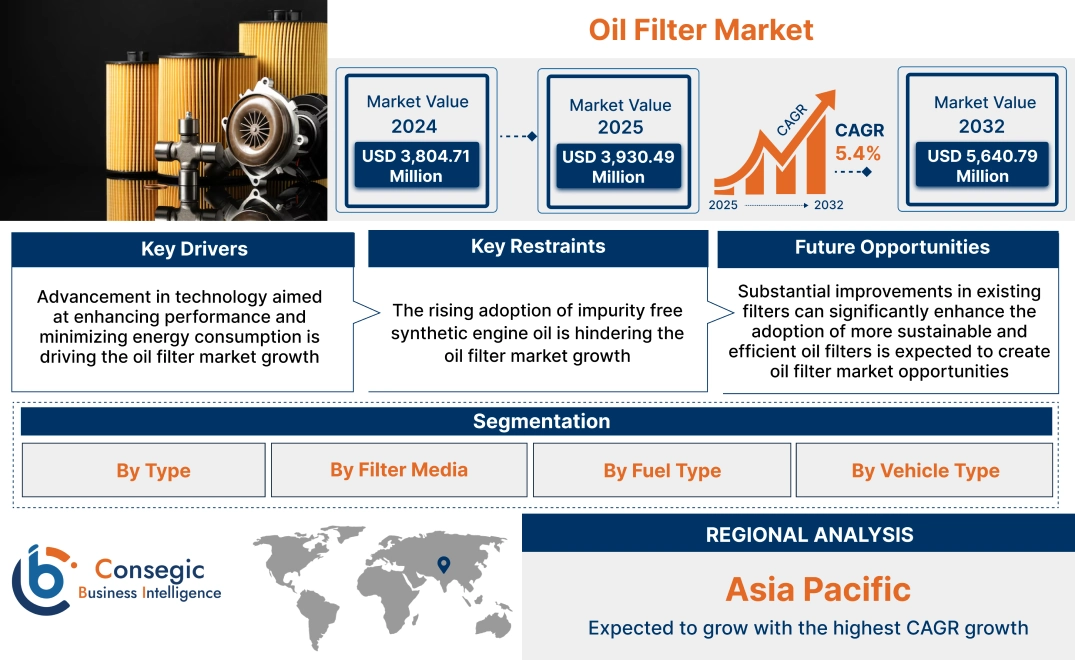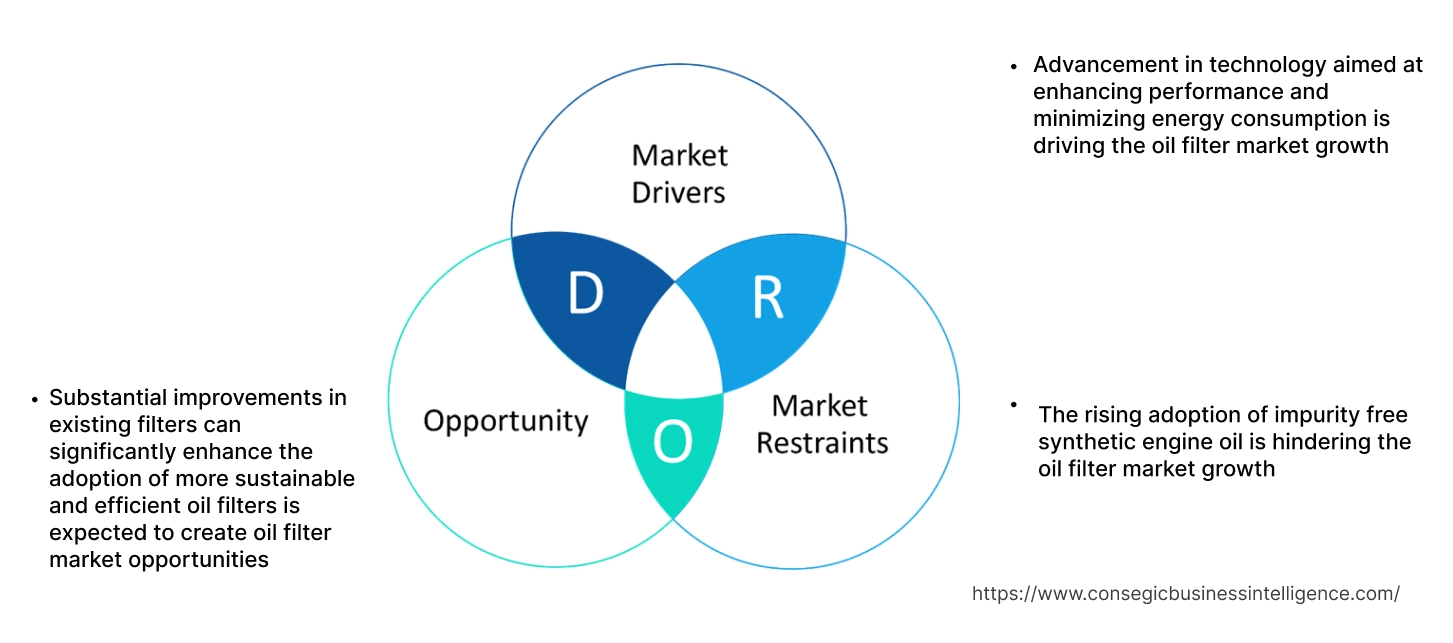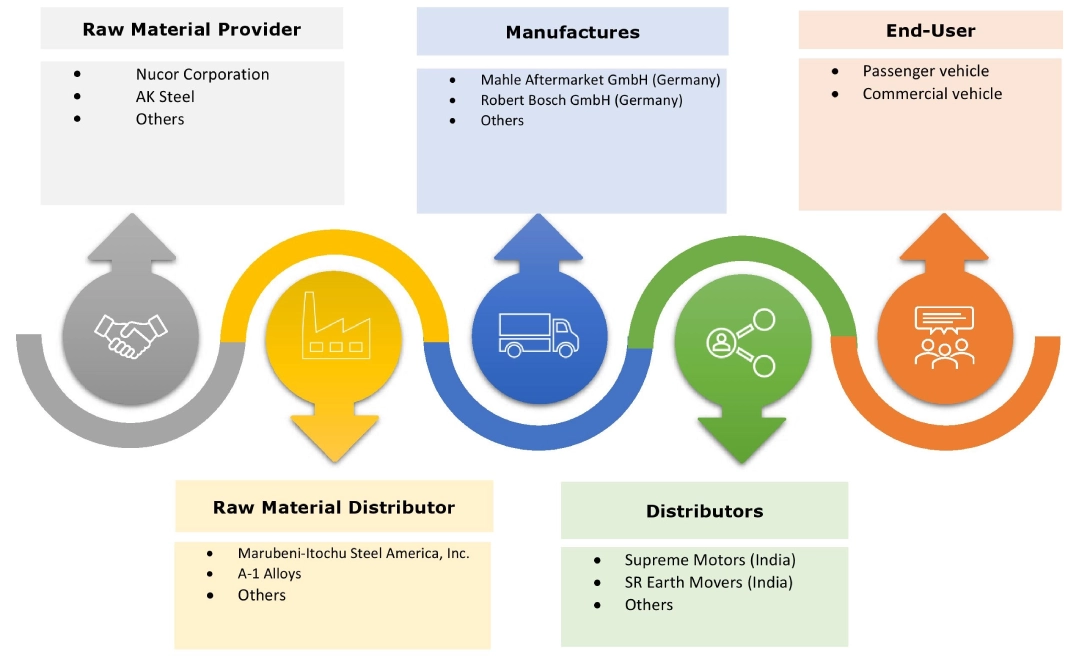- Summary
- Table Of Content
- Methodology
Oil Filter Market Size:
Oil Filter Market Size is estimated to reach over USD 5,640.79 Million by 2032 from a value of USD 3,804.71 Million in 2024 and is projected to grow by USD 3,930.49 Million in 2025, growing at a CAGR of 5.4% from 2025 to 2032.
Oil Filter Market Scope & Overview:
Oil filters are essential for engine health and removes abrasive particles from the lubricating oil that could damage engine components. The effectiveness of an oil filter is measured by its filtration efficiency, or its ability to capture particles of various sizes. High filtration efficiency ensures cleaner oil, leading to improved engine performance, lower energy consumption, and reduced overall maintenance costs. Additionally, using a high-quality oil filter is crucial for extending engine life and preventing costly repairs.
Key Drivers:
Advancement in technology aimed at enhancing performance and minimizing energy consumption is driving the oil filter market growth
The advancement in oil filter technology allows improved fluid cleanliness, sustainability, and protection from static charge generation along with providing a longer service life. Additionally, the alteration of new technologies such as stress-resistant filter technology enables lower energy costs and reduced filter, oil and system maintenance, providing a general reduction in the total cost of filtration for customers. Moreover, the performance improvement includes lower energy costs and a general reduction in total cost of filtration.
- For instance, in January 2022, Pall Corporation launched the new SupralonTM hydraulic and lube oil filter element range. Supralon filter elements incorporates stress-resistant technology (SRT) and anti-static properties, which ultimately help protect and prolong the life of equipment in hydraulic and lube oil application.
Thus, as per the analysis, the advancement in technology leading to cost cutting, while delivering best performance is driving the oil filter market size.
Key Restraints:
The rising adoption of impurity free synthetic engine oil is hindering the oil filter market growth
Scientifically formulated synthetic engine oils offer numerous advantages, including extended engine life, reduced environmental impact, and improved fuel efficiency. Additionally, synthetic oil withstands extreme temperatures ensuring efficient engine performance and protection under both hot and cold conditions. Moreover, it helps to reduce friction in engine components, leading to better performance in terms of fuel efficiency and a reduction in wear in the engine with time. Further, synthetic oils are free from such impurities and do not create sludge or deposits in the engine while enhancing the longevity of the engine.
Thus, as per the analysis, the increasing adoption of synthetic engine oil hinders the Oil Filter market size.
Future Opportunities :
Substantial improvements in existing filters can significantly enhance the adoption of more sustainable and efficient oil filters is expected to create oil filter market opportunities
The new oil filter systems are engineered to prevent electrostatic discharges, which prematurely degrades oil and increases maintenance cost. By minimizing differential pressure, these systems are expected to reduce energy consumption during operation. This enhanced efficiency not only lowers operating expenses but also contributes to a reduced carbon footprint, becoming more sustainable and cost-effective solution for various applications.
- For instance, in August 2024, HYDAC’S sustainmicron filter element prevents electrostatic discharges (ESD) and offers high bending stability and change stability. With an additional reduction in differential pressure of up to 30%, it combines three elements in one and will replace Optimicron, Optimicron, and Pulse and Stat-Free.
Thus, the adoption of sustainable, efficient, and secure oil filters is expected to further drive oil filter market opportunities.
Oil Filter Market Segmental Analysis :
By Type:
Based on the type, the market is segmented into fuel filter, engine oil filter, hydraulic filter, and others.
Trends in the Type:
- The development of high-efficiency synthetic media filtration in engine oil filter for better filtration and efficiency.
- The capability of fuel filter to separate dirt, and rust particles from the fuel, keeping them from entering the engine and causing damage is increasing the oil filter market trends.
Engine oil filter segment accounted for the largest revenue share in 2024
- The engine oil filter helps with the removal of particles and contaminants from the oil, which helps in the reduction of friction and heat inside the engine.
- Additionally, engine oil filtration helps in improving the overall efficiency of the engine and can prolong its life by reducing wear and tear due to its outstanding dirt-retention capacity.
- For instance, Mann- Filter’s new engine oil filter is developed using non-return membrane that keeps the engine oil in the filter as soon as the engine stops. This offers an optimized and faster oil supply on start-up, and can handle any technological challenges, with its outstanding dirt-retention capacity and high material resistance.
- Thus, the peak performance delivery by engine oils is driving the oil filter market demand.
Hydraulic oil filters are anticipated to register as the fastest CAGR in forecast period
- Hydraulic oil filter elements remove harmful particles from hydraulic oil due to their strong separation performance ensuring smoother operation.
- Furthermore, reducing risk of system failures, downtime, and expensive repairs, extending their service life.
- For instance, Hydraulic oil filter from MANN+HUMMEL minimizes downtime and ensures long service life of hydraulic components and machines, high dirt-holding capacity with minimal pressure drop, fast, easy and clean service.
- Thus, based on the analysis, the advancements offered by the hydraulic oil filters is driving the oil filter market expansion.
By Filter Media:
Based on the filter media, the Oil Filter market is segmented into cellulose, synthetic, and others.
Trends in Filter media:
- Synthetic media oil filters not only catch and remove smallest particulates, but also better withstand complex chemical reactions.
- Cellulose filter media is trending due to the combinations of fibres and resin systems, each providing different physical properties, chemical resistance, filtration efficiency, pressure drop, and flow characteristics.
The cellulose filter media accounted for the largest revenue share of 45.29% in the year 2024
- Cellulose is a natural polymer and is a highly effective material for filtering due to its superb strength and random fiber size.
- Cellulose is a great and cost effective way to filter out most contaminants in motor oil, it serves as a versatile filtration solution that functions by trapping contaminants and other particles within a matrix of fibers.
- For instance, Frantz Oil Filters cellulose filter media, removes up to 96% of containments, filters down the oil up to 2 microns, and is cost-effective.
- Thus, the cost-effectiveness of the cellulose filter media is driving the oil filter market trends.
The synthetic filter media is registered for fastest CAGR in forecast period.
- Synthetic filter media outperforms conventional materials, by efficiently handling thermal challenges, resisting aggressive chemicals in oils and fuels, and repelling water to prevent corrosion and lubrication issues.
- The filter media’s advanced features make them crucial for engines operating in demanding conditions, reducing maintenance costs and ensuring reliable operation.
- For instance, Gessner’s fully synthetic oil filter media offers enhanced durability, extended longevity, superior stability, and optimal oil flow.
- Thus, based on the oil filter market analysis, the growth of oil filter market is further driven by the efficiency, and reliability provided by the synthetic filter media.
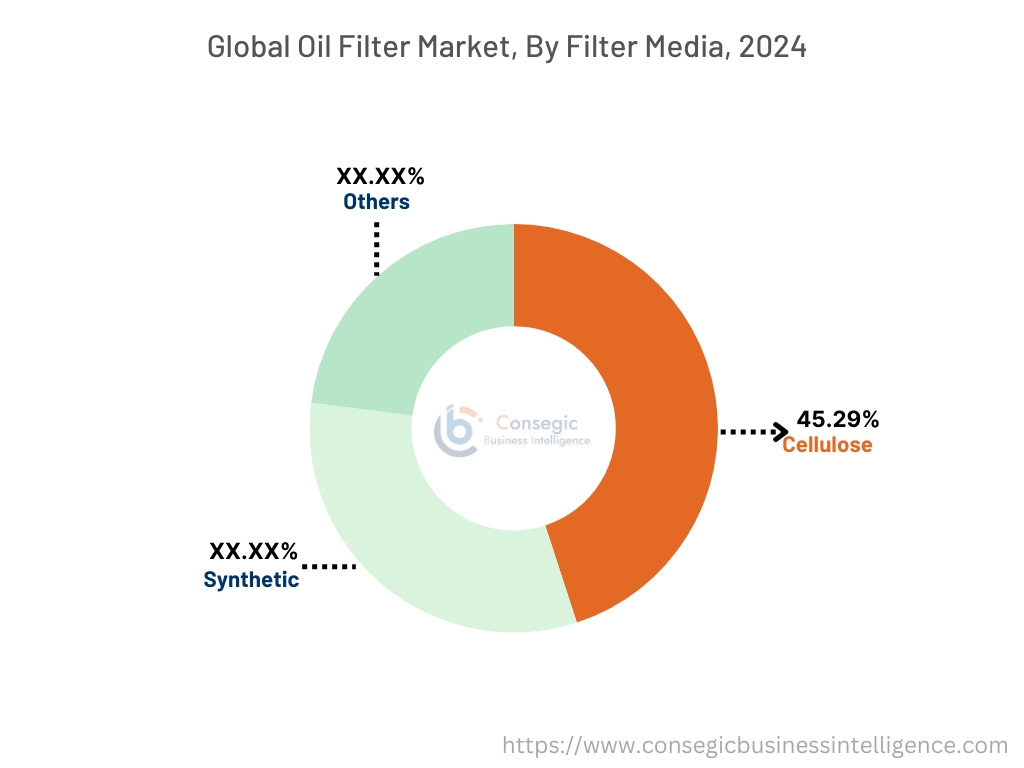
By Fuel Type:
Based on the fuel type, the oil filter market is segmented into diesel, gasoline, and alternative fuels (ethanol, CNG, etc.)
Trends in fuel type:
- From industrial operations to rural electrification, diesel gensets is a reliable source of power, especially in regions experiencing intermittent electricity supply.
- The growing trend for cleaner transportation options has driven the development and adoption of CNG vehicles across various sectors, including personal vehicles, commercial fleets, and public transportation systems.
Diesel accounted for the largest revenue in the year 2024 and fastest CAGR in forecast period.
- Diesel powered engines typically deliver 25 to 30 percent better fuel economy than similarly performing gasoline engines and are built to withstand the rigors of higher compression.
- Diesel engines compress more air faster, delivering more power to get work done. Features like a turbocharger allow extra air to enter a diesel engine so it can deliver on horsepower as well.
- For instance, Donaldson Filters for diesel engine’s offers a full range of lube filters for popular heavy-duty on- and off-road engines, and broad range of replacement filter coverage to fit systems built by other manufacturers
- Thus, as per the analysis, the advantages diesel powered engines are providing id further propelling the oil filter market demand.
By Vehicle Type:
Based on the vehicle type, the Oil Filter market is segmented into commercial, and passenger.
Trends in vehicle type:
- Trends in passenger vehicles for longer-lasting, high-efficiency filters, increasing focus on sustainability with eco-friendly material.
- The increasing trend of oil filters in commercial vehicles for real-time performance tracking and shift towards sustainable oil filters.
Passenger segment accounted for the largest revenue share in the year 2024 and fastest CAGR in forecast period.
- The fuel filter filters contaminants such as dirt, rust and other particles from the fuel before it gets into the engine to ensure engine’s performance and longevity.
- The oil filter is an unassuming yet critically important component that greatly contributes to the performance and lifespan of vehicles.
- For instance, based on the Australian bureau statistics, the passenger carrying vehicles are comprised of 93.8% passenger vehicles, 5.7% motor cycles and 0.6% buses.
- Thus, the wide usage of passenger vehicle is driving the oil filter market expansion.
Regional Analysis:
The global market has been classified by region into North America, Europe, Asia-Pacific, MEA, and Latin America.
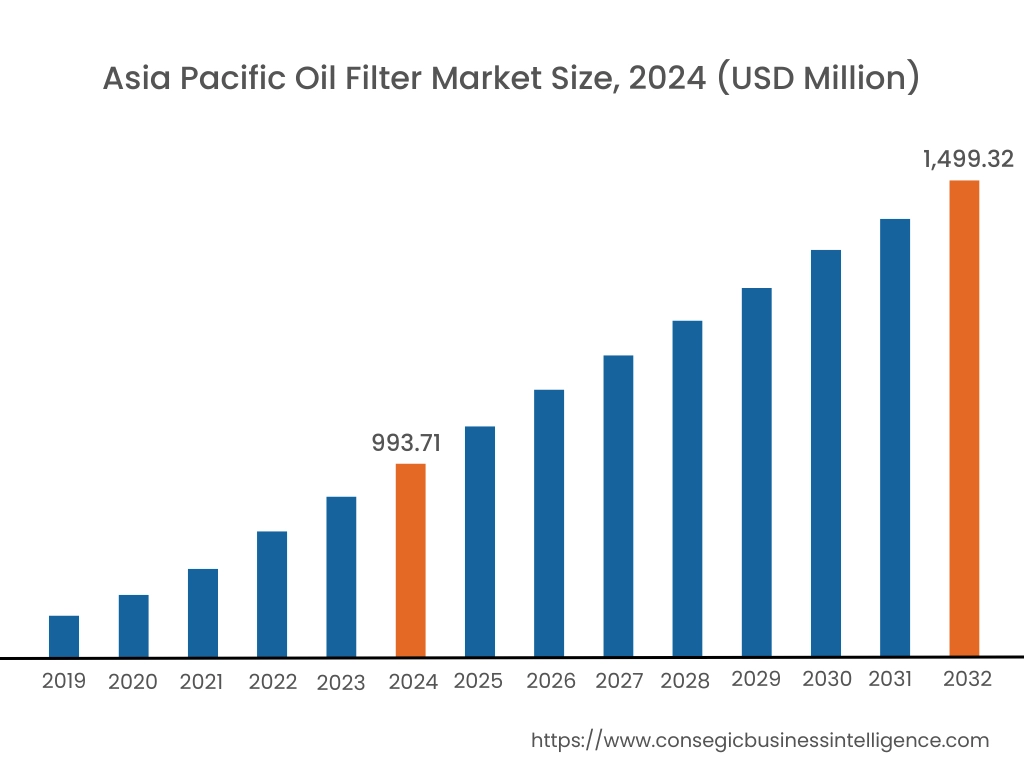
Asia Pacific region was valued at USD 993.71 Million in 2024. Moreover, it is projected to grow by USD 1,028.07 Million in 2025 and reach over USD 1,499.32 Million by 2032. Out of these, China accounted for the largest segment of 34.1% in 2024. The Asia Pacific region’s growth in oil filter market share due to the implementation of stringent emission regulations in different parts of the region. The Asia Pacific region has rapidly growing automotive sector, particularly in countries like China, India, and Japan. Additionally, the expanding industrial sector and development have contributed to the growth of the commercial, and marine segment by adopting more sustainable solutions seamlessly such as renewable diesel, made from 100% renewable raw material.
- For instance, in 2025, Neste, KPI OceanConnect and Global Energy collaborated delivered Neste my Renewable Diesel to the marine sector in Singapore. Made from 100% renewable raw materials, is a direct replacement to fossil diesel, suitable for all diesel engines, and its use results in up to 90% reduced GHG emissions over its life cycle compared to fossil diesel.
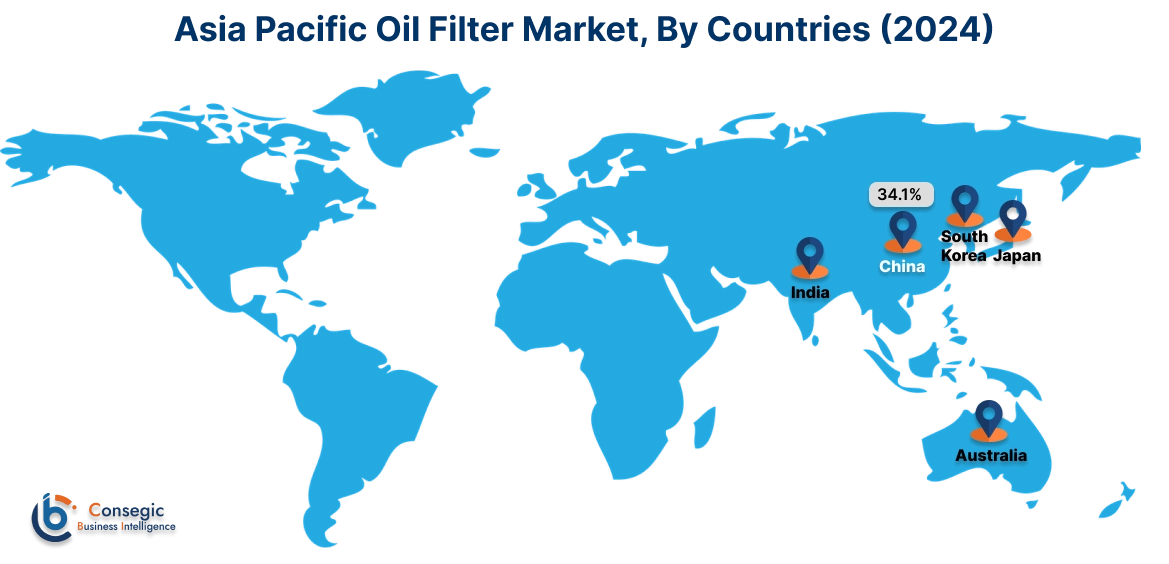
North America region was valued at USD 1,342.74 Million in 2024. Moreover, it is projected to grow by USD 1,387.16 Million in 2025 and reach over USD 1,991.20 Million by 2032. The region holds a significant amount of oil filter market share, due to the growth in automotive industry and a wide usage of commercial vehicles and passenger cars. Additionally, strict regulations regarding vehicle emissions and focus on best engine performance and longevity is driving the demand for high-quality oil filters in this region. Moreover, stringent emission norms and environmental regulations have made OEMs adopt new technologies leading to lower emissions. The increasing research and development and partnerships for developing more advanced products has led to the introduction of technologies which has increased the service-life of the filters.
- For instance, in September 2024, The Castrol – GKI partnership featured a line of automotive filters to enhance vehicle performance and longevity, to extend the comprehensive range of aftermarket solutions within the Castrol portfolio.
As per the oil filter market analysis, the growth of automotive industry in Germany and Western Europe drives demand for advanced oil filtration solutions. The market is evolving with the adoption of synthetic oils and a focus on sustainability. Online retail channels are rising, and manufacturers invest in research and development to meet market needs. Oil and gas industry drives demand for industrial oil filters in the Middle East and Africa. Heavy-duty vehicle filters are also in high demand due to growing construction and infrastructure development. Latin America's expanding automotive sector is driving a growing market for specialized oil filters, which are needed to maintain engines under diverse climate conditions. Manufacturers are adopting advanced filtration technologies to reduce vehicle emissions.
Top Key Players and Market Share Insights:
The market is highly competitive with major players providing oil filters to the national and international markets. Key players are adopting several strategies in research and development (R&D), product innovation, and end-user launches to hold a strong position in the market. Key players in the oil filter industry include-
- Mahle Aftermarket GmbH (Germany)
- Robert Bosch GmbH (Germany)
- Alco Filters Ltd.
- K&N Engineering Inc. (US)
- Ahlstrom-Munksjö (Finland)
- Cummins (US)
- Denso Corporation (Japan)
- Donaldson Company Inc. (US)
- Mann+Hummel (Germany)
- Hollingsworth & Vose (US)
Recent Industry Developments :
Partnerships & Collaborations:
- In November 2024, MANN+HUMMEL Partners with PT. Bquik Otomotif Indonesia to Offer Premium Automotive Filtration Solutions in Indonesia. Offering cutting-edge automotive filtration solutions through its aftermarket brands, WIX Filters and MANN-FILTER, in Indonesia.
- In 2024, Fleetguard, NanoNet, and StrataPore media collaborated to create a combination filter developed to meet and exceed engine requirements. The features included are higher particle removal efficiency, increased contaminant holding capacity, reduced flow restriction, especially under cold-start conditions, and reduced CO2 footprint.
Oil Filter Market Report Insights :
| Report Attributes | Report Details |
| Study Timeline | 2019-2032 |
| Market Size in 2032 | USD 5,640.79 Million |
| CAGR (2025-2032) | 5.4% |
| By Type |
|
| By Filter Media |
|
| By Fuel Type |
|
| By Vehicle Type |
|
| By Region |
|
| Key Players |
|
| North America | U.S. Canada Mexico |
| Europe | U.K. Germany France Spain Italy Russia Benelux Rest of Europe |
| APAC | China South Korea Japan India Australia ASEAN Rest of Asia-Pacific |
| Middle East and Africa | GCC Turkey South Africa Rest of MEA |
| LATAM | Brazil Argentina Chile Rest of LATAM |
| Report Coverage |
|
Key Questions Answered in the Report
How big is the Oil Filter Market? +
Oil filter market size is estimated to reach over USD 5,640.79 Million by 2032 from a value of USD 3,804.71 Million in 2024 and is projected to grow by USD 3,930.49 Million in 2025, growing at a CAGR of 5.4% from 2025 to 2032.
What specific segmentation details are covered in the Oil Filter report? +
The oil filter report includes specific segmentation details for type, filter media, fuel type, vehicle type, and regions.
Which is the fastest segment anticipated to impact the market growth? +
In the oil filter market, the synthetic filter media segment is the fastest-growing segment during the forecast period.
Who are the major players in the Oil Filter Market? +
The key participants in the Oil Filter Market are, Mahle Aftermarket GmbH (Germany), Robert Bosch GmbH (Germany), Alco Filters Ltd., Cummins (US), Denso Corporation (Japan), Donaldson Company Inc. (US), Mann+Hummel (Germany), Hollingsworth & Vose (US), K&N Engineering Inc. (US), Ahlstrom-Munksjö (Finland), and others.
